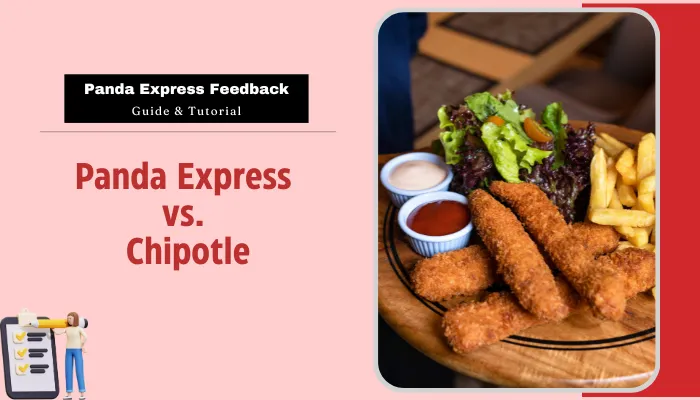Panda Express vs. Chipotle is a delicious and heavily debated topic in fast-casual restaurants. Each of them has a little something different to offer its customers in terms of cuisine and diet. Americanized Chinese dishes are presented beautifully by Panda Express with the famous Orange Chicken and Chow Mein on the menu.

Meanwhile, customers could enjoy healthy organic Mexican food, prepared however they like from burritos to salad bowls at Chipotle. This paper provides a detailed comparison of both organizations’ products, dining experience and customers’ preferences helping the readers consider which one is more appropriate for their cravings. Additionally, gathering Panda Express feedback can offer valuable insights into customer satisfaction and preferences, further enriching the comparison.

Panda Express vs. Chipotle: What’s the Difference?
In the world of fast-casual dining, Panda Express vs. Chipotle each offer distinct culinary experiences, drawing in customers with their unique flavors and menu options.
A. Panda Express
Panda Express which is a fast-casual Chinese food chain establishment, was established in 1983 by Andrew Cherng and Peggy Chen in Glendale California. Panda Express managed to rise to fame owing to reasonable prices provided with American-Chinese foods.
Core menu offerings:
The food available at Panda express lean more towards American-Chinese style with larger portions and more rich flavors. Some of the restaurant’s signature dishes include:
- Orange Chicken: Small crispy chicken coated with spicy orange sauce
- Honey Walnut Shrimp: Coated shrimps in a savory honey walnut sauce.
- Chow mein: Boiled noodles with vegetables and proteins of choice stir fried.
- Broccoli beef: Beef with broccoli as main ingredient stir-fried in a delicious sauce.
Overall, Panda Express offers a tasty and accessible take on American-Chinese cuisine.
B. Chipotle
The other similarly quick serving establishment is Chipotle Mexican grill, to many Americans who created it in 1993. Chipotle gives emphasis on high good quality and local ingredients to provide the best experience for their provided fast casual meals.
Core Menu Offerings:
Chipotle focuses on Mexican cuisine and offers a build-your-own meal format that allows customers to personalize their orders. The core menu features:
- Salads: Greens are made in Hudson food’s twisting salad bar which is built like a burrito. Chipotle also has many vegetarian items including food options such as Sofritas, brown rice, corn salsa approval with several types of sauces.
- Burritos: In this huge tortilla of refined flour there is embedded rice, beans, a type of protein, and toppings including salsas.
- Tacos: Both soft-shell and hard-shell are given and the fillings are mixed meats with fresh garnishing items.
- Bowls: Similar to burritos, except not wrapped in a tortilla. suitable for people on a low carb diet.
In summary, Chipotle delivers a fresh and customizable Mexican dining experience that prioritizes quality ingredients.
In the end, no matter the craving whether it be the strong tastes offered by American-Chinese cuisine or the fresh and build-your-own style of food that the Mexican cuisine has, Panda Express and Chipotle both have appetizing and fulfilling options for any type of meal.
Menu Comparison
This comparison will focus on food quality, ingredients and bestsellers of Panda Express and Chipotle to find out the competitive positions of these two fast food chains.
| Aspect | Panda Express | Chipotle |
|---|---|---|
| Food Quality and Ingredients | – Uses a mix of fresh and pre-prepared ingredients. – Focuses on flavor with signature sauces. – Menu leans towards Americanized Chinese cuisine. | – Committed to organic and locally sourced ingredients. – Emphasizes fresh vegetables and antibiotic-free meats. – Offers a wide range of customization options. |
| Popular Dishes | – Orange Chicken: Sweet and tangy battered chicken. – Beijing Beef: Crispy beef with bold flavors. – Kung Pao Chicken: A spicy, stir-fried dish with peanuts. – Vegetarian options available but limited. | – Burritos: Fully customizable with a choice of proteins, rice, beans, and salsas. – Tacos: Soft or crispy tortillas filled with fresh ingredients. – Bowls: A carb-conscious option without the tortilla. – Strong vegetarian and vegan options, including Sofritas (tofu). |
To sum up, we can say that both restaurants have something unique to offer. Especially regarding Panda Express American-Chinese tastes are essential, whereas at Chipotle it is possible to enjoy fresh hand-made Mexican food with an option to customize offerings.
Dining Experience
The dining experience at Panda Express vs. Chipotle varies significantly, with each restaurant offering its own unique atmosphere and service style to enhance customer satisfaction.
Atmosphere
- Panda Express: It is common for Panda Express to employ a low end and family oriented dining experience. The eating spaces are usually spacious and tidy and have adequate sitting arrangements. For the most part, the feeling is casual and hospitable.
- Chipotle: Chipotle has an urban and quick-service tone. The interiors are generally bright and inviting devoid of clutter with a speedy service orientation. It is many a time said and can be felt which is also true to many in daily rush hours, the ambiance is very lively and busy.
Service Style
- Panda Express: It is a quick-service establishment where guests place their orders at the counter and pick up their food immediately. Such a system is effective in reducing the time that customers spend in a restaurant.
- Chipotle: When purchasing a meal at Chipotle, the customers construct their own meal with the help of the employees. This interactive option is beneficial in that creative ways of making meals are possible although it may take time especially when there is high traffic.
Both restaurants, be it Panda Express where you can sit in a relaxed family atmosphere or Chipotle, which has a more colorful and busy surrounding, aim to provide great dining experiences specific to their unique food types.
Pricing Comparison
In this section, we’ll compare the pricing strategies of Panda Express and Chipotle to see which restaurant offers better value for your meal.
| Pricing Aspect | Panda Express | Chipotle |
|---|---|---|
| Average Meal Price | $10 – $15 | $10 – $15 |
| Value Meals Available | ✔️ (Combo meals) | ✔️ (Kid’s menu and specials) |
| Customization Options | ❌ (Limited customization) | ✔️ (Fully customizable) |
| Promotions/Deals | ✔️ (Limited time offers) | ✔️ (Loyalty program and specials) |
| Vegetarian/Vegan Options | ✔️ (Some options available) | ✔️ (Wide variety available) |
| Size/Portion Sizes | ✔️ (Large portions) | ✔️ (Large portions) |
In conclusion, when it comes to pricing, both Panda Express and Chipotle offer similar value, but Chipotle stands out with its customization options and commitment to quality ingredients, making it a preferred choice for health-conscious diners.
Customer Preferences
Customer preferences play a crucial role in the success of both Panda Express and Chipotle, influencing brand loyalty and choices driven by health considerations.
A. Popularity and Brand Loyalty
Panda Express mainly serves quick and flavorful meals that make customers very willing to eat it, although it has been criticized for authenticity and healthiness on the other hand because of the overuse of sugar and sodium. Chipotle has many fans because of the fresh and made-to-order meals, so does the service but Chipotle has had service issues before and also had past food safety issues.
Both brands maintain good engagement on their social media. Panda Express focuses on new items and community content whereas Chipotle utilizes comedy and environmental initiatives for the individuals to be loyal, hence increasing engagement.
B. Health Considerations
Customers are treated to Chipotle’s organic options, especially the vegetarians and vegans, which are however still healthier than environ situated fast-food restaurants. Conversation arises with consumers as Panda Express continues making their grab-and-go environmental food toward the light menu but faces its challenges with fast-food image and calorie dense food.
As diners navigate their culinary options, the distinct feedback, social media engagement, and health trends surrounding these two fast-casual giants shape their appeal and reflect the evolving landscape of consumer dining preferences.
Conclusion
When comparing Panda Express vs. Chipotle, the two restaurants are quite the opposite from the ambience to the menu. While at Panda Express, patrons can enjoy the rich flavors of American-Chinese dishes, Chipotle brings a whole new level of fast food by focusing on organic food and the ability to make your own meal.
In the end, it could be a matter of preference with respect to the flavors, health, and the ambiance, each brand has their own set of clientele and health concerns products.
